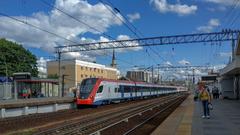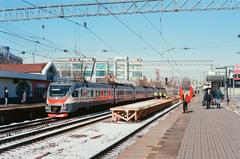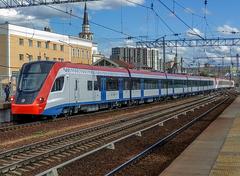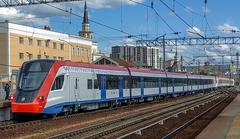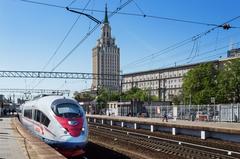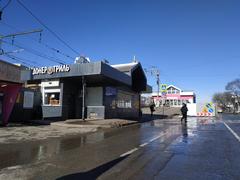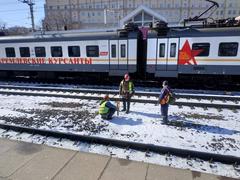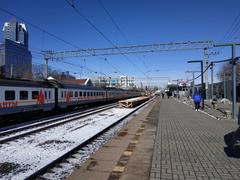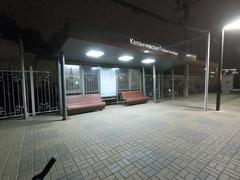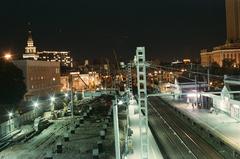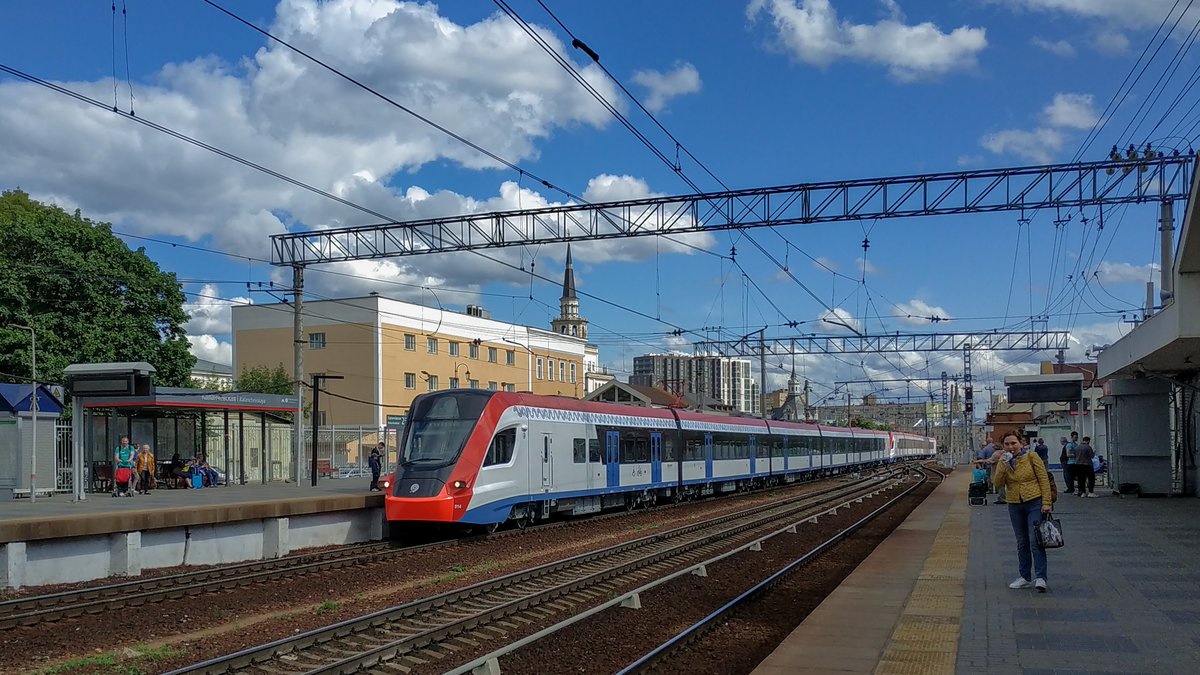
Ploschad Tryokh Vokzalov Visiting Hours, Tickets, and Moscow Historical Sites Guide
Date: 15/06/2025
Introduction
Ploschad Tryokh Vokzalov—commonly known as Three Station Square—is a bustling urban landmark in Moscow, Russia, renowned for its convergence of three major railway terminals: Leningradsky, Yaroslavsky, and Kazansky stations. This square not only functions as one of the busiest transport hubs in the country but also serves as a living testament to Moscow’s architectural evolution, historical milestones, and cultural vibrancy. Whether you are a traveler embarking on a Trans-Siberian journey or a history enthusiast exploring Moscow’s heritage, understanding the square’s origins, visiting hours, ticketing procedures, and nearby attractions will ensure a rewarding and efficient visit. For background and more detailed visitor info, see Komsomolskaya Square (Moscow) - Wikipedia and Touristam’s guide to Ploschad Tryokh Vokzalov.
Contents
- Historical Overview
- Origins and Development
- Architectural Highlights
- Role in Transport and Society
- Visitor Information
- Visiting Hours
- Ticketing
- Accessibility
- Travel Tips
- Nearby Attractions
- Architectural and Cultural Highlights
- Navigating the Square
- Frequently Asked Questions (FAQ)
- Conclusion and Recommendations
- Sources
Historical Overview
Origins and Development
Ploschad Tryokh Vokzalov’s history is deeply intertwined with the rapid expansion of Russia’s railway network in the 19th and early 20th centuries. Originally known as Kalanchyovskoye Field, the site was chosen for the Nicholas (now Leningradsky) Railway Station, which opened in 1851 as the Moscow terminus of the Moscow–Saint Petersburg Railway. Yaroslavsky Station followed in 1862, becoming the starting point of the legendary Trans-Siberian Railway, and Kazansky Station was completed in 1864, serving southeastern Russia and the Volga region (Komsomolskaya Square (Moscow) - Wikipedia).
The proximity of these three monumental stations was a deliberate urban planning decision, facilitating efficient movement of people and goods across the Russian Empire. The square was renamed Komsomolskaya in 1932 to honor the Communist youth organization, though the local name “Ploschad Tryokh Vokzalov” persists (Touristam).
Architectural Highlights
Each station embodies a different era of Russian architecture:
- Leningradsky Station: Designed by Konstantin Thon, it features neoclassical motifs echoing the grandeur of the Moscow Kremlin.
- Yaroslavsky Station: Fyodor Shekhtel’s design utilizes Russian Revival and Art Nouveau elements, with folkloric motifs and murals depicting Siberian landscapes, underscoring its role as the Trans-Siberian Railway’s gateway.
- Kazansky Station: The largest of the trio, designed by Alexey Shchusev (also of Lenin’s Mausoleum fame), combines Tatar, Russian, and Art Deco styles, crowned by a clock tower inspired by Kazan’s Söyembikä Tower (Touristam).
The ensemble is completed by the Stalinist-era Hotel Leningradskaya and the opulent Komsomolskaya Metro Station beneath the square, famous for its mosaics and baroque grandeur (Rusmania).
Role in Transport and Society
The square acts as the main rail gateway to Moscow, handling millions of passengers annually and connecting the capital to Saint Petersburg, the Russian North, the Volga, Siberia, and beyond. The Komsomolskaya Metro Station serves as a vital interchange between the Circle (Line 5) and Sokolnicheskaya (Line 1) lines, while recent infrastructure upgrades have improved accessibility and connectivity (Transport in Moscow - Wikipedia; Moscow Kalanchyovskaya railway station - Wikiwand).
Historically, the square has witnessed significant events, from World War II mobilizations to Soviet-era travel booms, encapsulating the dynamism of Moscow’s urban life.
Visitor Information
Visiting Hours
- Square and Station Exteriors: Open and accessible 24/7.
- Ticket Offices and Customer Service: Typically operate from 6:00 AM to 11:00 PM.
- Metro Station (Komsomolskaya): Open approximately 5:30 AM–1:00 AM.
- Trans-Siberian Railway Museum (Yaroslavsky Station): 10:00 AM–6:00 PM, Tuesday–Sunday (closed Mondays).
Ticketing
- Train Tickets: Purchase online via official Russian Railways sites, at station ticket offices, or through authorized agents. Passport required for long-distance travel.
- Metro Tickets: Buy at station booths or via the Moscow Metro app. The Troika card is recommended for multi-modal travel.
- Museum Entry: Trans-Siberian Railway Museum tickets cost approximately 300 RUB.
Accessibility
All three stations and the metro feature ramps, elevators, and tactile paving. Recent renovations have further improved accessibility, though certain historic areas may pose minor challenges. Staff assistance is available at information desks (Rusmania; Hikersbay).
Travel Tips
- Best Times to Visit: Early mornings or late evenings are less crowded. Avoid weekday rush hours for a more relaxed experience.
- Safety: The square is well-patrolled, but remain vigilant against pickpocketing. Use official taxi apps and keep valuables secure.
- Weather: Moscow’s winters are cold (average January -6°C), summers are warm (average July 24°C). Dress accordingly.
- Language: English is common at information desks, but a translation app is useful.
Nearby Attractions
- Red Square and the Kremlin: A few metro stops away.
- Sokolniki Park and Prospekt Mira: Easily accessible for leisure and dining.
- Bolshoi Theatre and the Atrium Shopping Mall: Short metro rides or walks.
- Stalinist Komsomolskaya Metro Station: A must-see for architecture enthusiasts.
Architectural and Cultural Highlights
Ploschad Tryokh Vokzalov offers a unique visual and cultural experience:
-
Leningradsky Station: Neoclassical façade and stately interiors.
 Alt text: Leningradsky Station facade at Three Station Square, Moscow – neoclassical architectural style.
Alt text: Leningradsky Station facade at Three Station Square, Moscow – neoclassical architectural style. -
Yaroslavsky Station: Russian Revival motifs and murals celebrating the Trans-Siberian legacy.
-
Kazansky Station: Eclectic blend of Russian, Tatar, and Art Deco elements; vast and ornate halls.
-
Hotel Leningradskaya: Stalinist skyscraper, now a Hilton hotel, symbolizing postwar Soviet grandeur.
 Alt text: Hilton Moscow Leningradskaya Hotel, a Stalinist era skyscraper at Three Station Square.
Alt text: Hilton Moscow Leningradskaya Hotel, a Stalinist era skyscraper at Three Station Square. -
Komsomolskaya Metro Station: Renowned for its mosaics and chandeliers, reflecting the theme of Russian heroism (Rusmania).
Navigating the Square
- Orientation: The three stations are side by side, each with distinct entrances and signage, and are connected by underground passages with shops and kiosks.
- Transport: The metro is the fastest way to the square. City buses, trams, and taxis are also available, but traffic can be heavy.
- Amenities: Luggage storage, restrooms, cafes, shops, and accommodation (notably the Hotel Leningradskaya) are available in or near all stations.
- Safety and Security: High police visibility and security cameras ensure a generally safe environment, but be alert in crowded areas.
Frequently Asked Questions (FAQ)
Q: What are the main visiting hours?
A: The square and station exteriors are open 24/7. Ticket offices and services typically run 6:00 AM–11:00 PM. The metro operates from 5:30 AM–1:00 AM.
Q: How do I buy train tickets?
A: Online at Russian Railways’ official website, at station counters (bring your passport), or via authorized agents.
Q: Is the area accessible for people with disabilities?
A: Yes, most facilities are accessible, with ramps, elevators, tactile paving, and staff assistance.
Q: Are guided tours available?
A: Yes, guided tours focusing on architecture, history, and the metro can be booked with local operators.
Q: What are the best times to visit to avoid crowds?
A: Early mornings, midday, or weekends tend to be less crowded than weekday rush hours.
Conclusion and Recommendations
Ploschad Tryokh Vokzalov embodies Moscow’s historical depth, architectural diversity, and modern-day dynamism. Whether you are arriving for a journey across Russia or exploring the city’s heritage, the square’s accessibility, amenities, and strategic location make it an essential stop for any visitor. For train schedules, ticketing, and further travel planning, consult official Russian Railways portals and reliable tourism resources like Rusmania and Hikersbay.
Make the most of your visit:
- Plan ahead for tickets and tours.
- Use the metro for efficient city travel.
- Take time to appreciate the architectural splendor.
- Download the Audiala app for audio guides, travel tips, and real-time updates.
